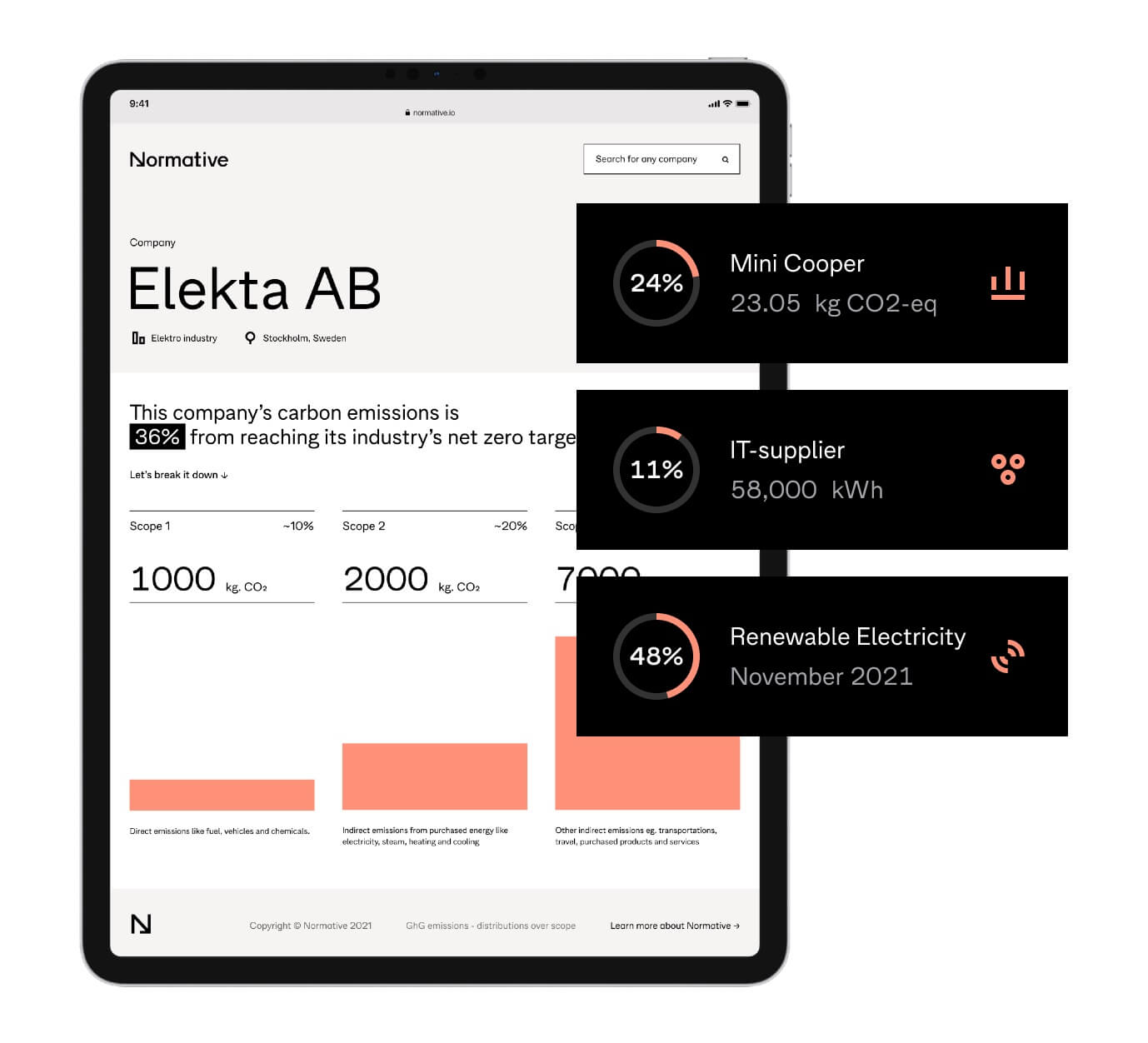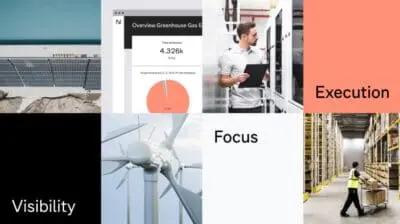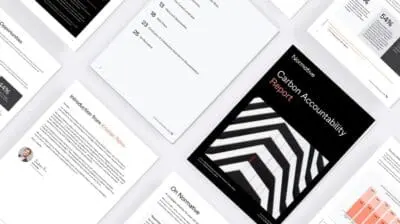Carbon reporting for businesses: a four-step plan

Your business can use carbon accounting to ensure accurate and compliant reporting.
As carbon reporting season approaches, businesses are preparing to disclose their climate impacts to legislators and stakeholders.
Carbon reporting requirements vary across regions and industries. However, there’s a basic formula that can help every business report effectively.
Follow the four-step plan below to accurately and comprehensively report your business’s carbon emissions – keeping you compliant, bringing you competitive advantages, and empowering your journey to net zero.
Understand your reporting requirements
The first step toward effective carbon reporting is determining your business’s relevant directives or frameworks.
Does legislation in your country or region require you to report your climate impact? Or, if you’re reporting voluntarily to meet stakeholder expectations, is there a certain framework you should follow?
Once you gain an overview of the KPIs that need to be measured, you can identify the internal processes and resources required to report them.
It can be intimidating to try to decipher the complex landscape of frameworks and mandates. Use Normative’s free Carbon Legislation Tracker to get an overview of your business’s obligations and options in only a few minutes.
Learn your carbon reporting requirements
Answer five simple questions to determine the mandatory reporting requirements, voluntary frameworks, and industry-specific guidelines that apply to your business.
Go to the Carbon Legislation TrackerCollect relevant data
To effectively report your carbon emissions, your business will need to use carbon accounting.
Carbon accounting is a way of measuring how much greenhouse gas an organization emits. Like financial accounting, carbon accounting quantifies the impact of an organization’s business activities – though instead of financial impact, it measures climate impact.
Effective carbon accounting requires lots of data on your business’s transactions and activities. Start the data collection process by determining:
- What data is needed for carbon accounting?
- Where does this data sit in the organization?
- How can this data be collected?
To report your full climate impact, you will need to collect data on sources of emission in both your operations and your value chain. The GHGP divides these emissions sources into three scopes:
Comprehensive carbon accounting will calculate a business’s emissions across all three scopes.
To achieve these calculations, you will need to collect specific types of input data for each scope.
The table below gives a brief overview of each scope’s requirements for input data, as well as where that data can most often be found within businesses.
| Scope | Emissions type | Example activities | Input data | Where to find this data |
|---|---|---|---|---|
| Scope 1 | Operational | Mobile combustion Stationary combustion Fugitive emissions | Fuel amount used Distance driven Refrigerants refilled | Fleet management Leasing company Facility management |
| Scope 2 | Operational | Electricity Heating Cooling Steam | Energy amount purchased Energy tariffs chosen | Asset /facility management Rental company Utility bills |
| Scope 3 | Value chain | All upstream and downstream activities not included in scopes 1 or 2 | Transaction data Activity data | Suppliers Logistics providers Employee surveys Product analyses Franchises ERP system |
As the table shows, there are many sources of emissions for which your business will need to account.
To make the process more manageable, you should begin by focusing on the most emissions-intensive areas of your business’s operations and value chain. The Greenhouse Gas Protocol provides criteria for identifying the relevant scope 3 activities.
Bear in mind that collecting data is a cross-company effort. Though the sustainability manager may lead the greenhouse gas inventory project, they often do not own the data itself, and will rely on support from other stakeholders in the business to collect it.
Finally, remember that your carbon reporting data collection will become more streamlined year by year, as your business – and its carbon accounting – builds on past learnings.
Accurate and compliant carbon accounting
Normative’s carbon accounting engine empowers your business to measure its full emissions, keeping you compliant, competitive, and equipped to reach net zero.
Report and interpret the results
With all of your input data collected and fed into your carbon accounting provider, it’s time to report and interpret the results.
You will have to format your emissions data to fit whichever carbon reporting framework or mandate you’re reporting to. Normative’s software-based carbon accounting enables you to export your emissions data in compliance-ready formats – including One-Click Reporting for major legislations like CSRD and SECR.
Depending on your reporting requirements or stakeholder agreements, you may also need to have your report audited by a third party.
One of the benefits of using carbon accounting software like Normative is that, in addition to retrieving the calculations needed for reporting, you will also receive interactive visualizations of your emissions. These visualizations give you an overview of your organization’s full greenhouse gas inventory while also enabling you to drill down to specific sources, like the emissions from certain geographic regions or departments. This package of comprehensiveness and granularity is a powerful ally on your carbon reduction journey.

When interpreting your results, look to the sustainability leaders in your industry: how do their emissions profiles compare to yours?
Many businesses, after seeing their full emissions for the first time, find the breakdown of their value chain emissions especially insightful. For example, the Normative customer Flying Tiger Copenhagen – a global retailer with 800+ locations – discovered that textiles were an unexpectedly large source of emissions. This realization enabled them to look for more climate-friendly alternatives.
Carbon accounting success story: Flying Tiger Copenhagen
Flying Tiger used Normative’s carbon accounting to measure its full value chain emissions – and discover some unexpected hotspots.
Go to the customer story
Make the business case for climate action
The trend is clear: regulators, financial institutions, and consumer expectations are demanding that businesses make significant and verifiable reductions to their emissions.
This means that climate action is no longer a “nice-to-have” for businesses – it’s a core strategic necessity.
The businesses that start taking action now will experience a wealth of business benefits. These benefits include improved brand equity and employee engagement, and accordingly, an increase in profitability.
Carbon reporting can help you build a business case for climate action within your company.
You can use your emissions calculations to convince your company’s leadership to focus decarbonization initiatives on particularly high-emitting activities. As you make reductions to your emissions, your carbon reporting will verify the results to your company’s leadership – as well as provide greenwashing-resistant proof of your sustainability work to investors, regulators, and customers.
The first step toward action is to understand where you are. With accurate and compliant carbon reporting, you give your business a thorough understanding of its current climate impact, laying the foundation on which to build a climate-friendly, profitable, and future-proof path forward.
The carbon reporting checklist, in summary
- Understand your reporting requirements.
- Collect all the relevant data from within your organization’s operations and value chain.
- Report and interpret the results.
- Use your carbon reporting as a foundation for taking climate action.
Accurate and compliant carbon accounting
Normative’s carbon accounting engine empowers your business to measure its full emissions, keeping you compliant, competitive, and equipped to reach net zero.











